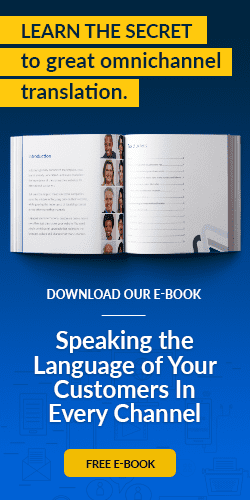Global customers react positively when companies serve them online in their preferred languages, localized for their markets.
Is your company doing that?
If not, your organization isn’t just blowing an opportunity for increased traffic, engagement and conversions. You’re actively defying the expectations of your global customers, and sabotaging your chances of international success.
The Need, and the Stakes
Your global customers don’t just want translated sites—they expect them. As a marketer, you need to think of website translation as a “must have” part of your marketing and lead-gen toolbox. Consider the widespread expectation for brands to be on social media channels. Website translation is no different. If you want to succeed in new markets, it’s necessary.
Why? People want to feel understood and appreciated. Customers have more trust for companies that serve them in their preferred languages—especially when that content is localized for the specific linguistic and cultural nuances of their markets. People like and react well to personalized marketing. It makes them more likely to do business with that company.
Culturally-authentic translations tell global customers that you care about them, and understand their needs.
That’s a big deal, especially for a company that might be in the nascent days of serving a new online market. In these instances, their brand isn’t well known, and they need as many differentiators against competitors as possible.
Accurate, culturally-authentic translations quietly send the signal to customers that this isn’t just an opportunistic, transactional experience. It suggests that the brand cares about them and their market, and understands their needs.
The old saying “fish where the fish are” applies in these new markets, too. Don’t just translate your website. Make sure to translate content for social, mobile, omnichannel, in-store use, and emails.
Execution Is Everything
It’s easy to recognize the value of a localized website. It’s harder, though, to do it right. Some companies naively believe they can perform a website translation project’s technical, operational and translation workflows in-house. This often result in costs overruns, delays and substandard online experiences. Those do more harm to a brand than good.
In-house approaches to website translation are risky and error-prone—and often do more harm than good.
Savvy companies use technology-driven solutions—such as the turn-key proxy-based approach to translation—to translate, deploy and operate their multilingual sites. Turn-key solutions eliminate the technical and operational minefields associated with website translation … and much of the costs, too. They’re fast to market, and play nicely with all web technologies. Consider:
Technology: Many companies can provide good translation. But fully turn-key solutions are designed to handle all of the under-the-hood complexities that make website translation such a burden for your IT team.
Effortless: Turn-key solutions require no effort from you at launch, and ongoing. All personnel, processes and technology are provided by the vendor.
Customer-Aligned: Many vendors try to maximize your translation spend. But the best turn-key solutions provide ways to ensure your international success, so that you can keep adding languages—and expanding your global reach.
Most important, the linguists who work at these agencies are great at translating content for your target markets. Not only are they native speakers, they’re fluent in the cultural nuances of those markets, and the buying habits of those residents.
These translators know what to say, and how to say it, in ways that feel “like a local”—while remaining absolutely faithful to your brand’s voice, verve and business goals.
Conclusion
Serving your global customers in the languages they prefer is just as important to your business as any other key marketing approach.
Using a digital-first translation agency that combines technical solutions with human expertise will help you find the audience you’re looking for across media by winning their hearts and minds and, most importantly, their business and trust.
Last updated on December 27, 2017